Introducing BSCS’s New Flagship High School Biology Program
Teachers are being asked to do a lot in today’s science classrooms. That includes teaching the Next Generation Science Standards, which are challenging in both depth and breadth. BSCS has responded to this need by creating a brand new high school biology program that supports teachers in meeting these standards. But we didn’t stop there.
Our new program, BSCS Biology: Understanding for Life, has a greater purpose. It is designed to prepare high school students for life in our complex, interconnected world.
The program includes four units, each centered around a 21st century societal challenge that we can no longer ignore, such as antibiotic-resistant infections. Students are challenged to investigate. They “figure out” rather than “learn about” scientific phenomena. This approach is different. It requires a different kind of work. And the unfamiliar can be frustrating, at first—especially for students who have learned to play the game of school by memorizing facts to get an A.
However, as we’ve seen through field testing and initial program adoption in 2020-2021, this approach is powerful. And teachers believe this program is going to change the way students learn and use science throughout their lives.
Key Program Features
- Introduces BSCS’s new Anchored Inquiry Learning instructional model, which builds on the strengths of our globally recognized 5E model, while drawing on contemporary research about the social, cultural, and emotional aspects of the learning process
- Designed from the ground up to support teachers in meeting the Next Generation Science Standards
- Specifically integrates supports for English language learners and students with below-grade-level literacy skills
- Directly addresses societal challenges we can no longer ignore, while allowing students to investigate compelling and relevant phenomena that will keep them from ever asking, “Why do I need to know this?”
- Equips students with abilities and inclinations to act on what they’ve learned well beyond high school biology class and into their future personal, professional, and civic lives
Inside the Units
BSCS Biology: Understanding for Life includes four units, each centered around a societal challenge. High school students investigate an anchoring phenomenon while developing the knowledge, abilities, and inclinations to take positive action on behalf of themselves, their communities, and the natural world.
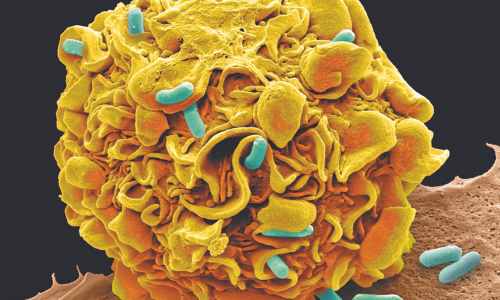
Unit 1: Infectious Diseases
How can bacterial infections make us sick, and why are they getting harder to treat?
Key Concepts
- Body systems & specialized cells
- Homeostasis & feedback
- Natural selection
Unit 2: Hereditary-Genetic Disease
Why are some people at higher risk for heart disease than other people?
Key Concepts
- DNA structure determines protein structure
- Meiosis & crossing over
- Mitosis & differentiation
- Environmental influence on traits


Unit 3: Matter and Energy
How can we sustainably feed our growing population a nutritious diet?
Key Concepts
- Photosynthesis & cellular respiration
- Matter & energy flow
- Trophic levels
- Carbon cycle
Unit 4: Biodiversity and Humans
Why are coyotes expanding their range while so many other organisms are becoming endangered?
Key Concepts
- Ecosystem interactions & carrying capacity
- Disturbance & anthropogenic change
- Speciation, extinction, & evolution
- Biodiversity & ecosystem services

Toolkit for Teachers
Learn more about this new high school biology program on Kendall Hunt Publishing Company’s website.
The OpenSciEd initiative was launched to address a critical need in science education: the need for high quality science instructional materials that are standards-aligned and practical for broad implementation. Led by BSCS Science Learning, a national consortium of curriculum developers and researchers created a three-year middle school science program for free distribution.
The program’s classroom materials and associated teacher professional learning materials are
- designed to align with the NRC Framework for K-12 Science Education and the Next Generation Science Standards (NGSS),
- based on research on student learning and teacher practice,
- developed in collaboration with teachers and field-tested in hundreds of classrooms in ten states across the United States,
- open-source and locally adaptable, and
- continuously improved based on feedback from teachers and field testing.
The complete, three-year middle grades science program is now available for free download at openscied.org.
Learn more about select units below.
Weather, Climate & Water Cycling
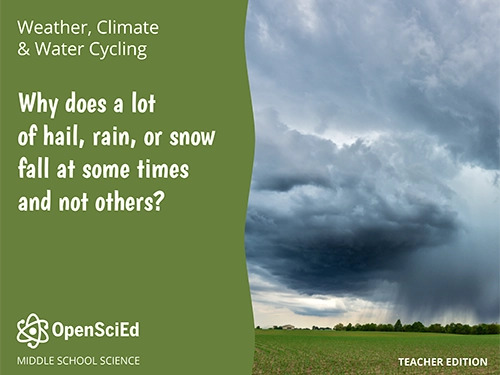
This 6th grade unit on weather, climate, and water cycling is broken into four separate lesson sets. In the first two lesson sets, students explain small-scale storms. In the third and fourth lesson sets, students explain mesoscale weather systems and climate-level patterns of precipitation. Each of these two parts of the unit is grounded in a different anchoring phenomenon.
The unit starts out with anchoring students in the exploration of a series of videos of hailstorms from different locations across the country at different times of the year. The videos show that pieces of ice of different sizes (some very large) are falling out of the sky, sometimes accompanied by rain and wind gusts, all on days when the temperature of the air outside remained above freezing for the entire day. These cases spark questions and ideas for investigations, such as investigating how ice can be falling from the sky on a warm day, how clouds form, why some clouds produce storms with large amounts of precipitation and others don’t, and how all that water gets into the air in the first place.
The second half of the unit is anchored in the exploration of a weather report of a winter storm that affected large portions of the midwestern United States. The maps, transcripts, and video that students analyze show them that the storm was forecasted to produce large amounts of snow and ice accumulation in large portions of the northeastern part of the country within the next day. This case sparks questions and ideas for investigations around trying to figure out what could be causing such a large-scale storm and why it would end up affecting a different part of the country a day later.
Matter Cycling & Photosynthesis
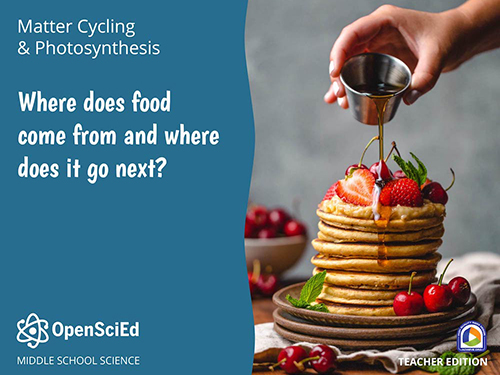
This 7th grade unit on matter cycling and photosynthesis begins with students reflecting on what they ate for breakfast. Questions about where their food comes from lead them to consider which breakfast items might be from plants. Then students explore (and taste) a common breakfast food, maple syrup, and see that according to the label, it is 100% from a tree.
Students apply what they learned in a previous unit to argue that they know what happens to sugar in syrup or other foods when they consume it. Students explore what else is in food and discover that foods from plants not only have sugars but proteins and fats as well. This discovery leads them to wonder how plants are getting these food molecules, why a plant needs food, and where a plant’s food comes from in the first place. Students figure out that they can trace all food back to plants, including processed and synthetic food. They explain that the pieces of their food are constantly recycled between living and nonliving parts of a system.
Forces at a Distance

This 8th grade unit launches with a slow motion video of a speaker vibrating. Students explore the cause of a speaker’s vibration as opposed to the effect.
Students dissect speakers to explore what’s inside, and they build homemade cup speakers. They identify that speakers of all kinds have some of the same parts—a magnet, a coil of wire, and a membrane. Students investigate each of these parts to figure out how they work together in the speaker system. Along the way, students manipulate the parts to see how this technology could be modified to apply to systems in very different contexts, like MagLev trains, junkyard magnets, and electric motors.
Thermal Energy
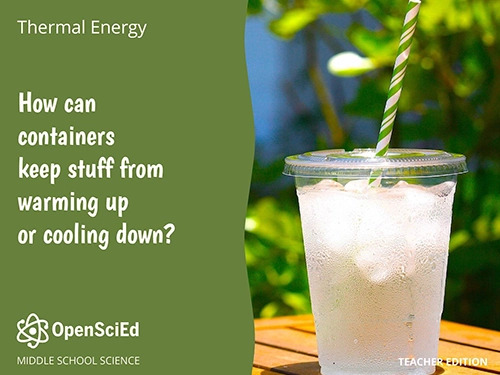
This unit on thermal energy engages students in a design challenge to create a cup that keeps drinks cold longer. They identify the features that make some cups better at keeping drinks cold, and they construct their own models to explain how those features prevent the transfer of thermal energy.
In this unit for 6th grade, students build an understanding of energy transfer within and between materials based on a particle model, and they work on the practices of modeling, conducting investigations, constructing explanations, arguing from evidence, and designing solutions.
Metabolic Reactions

This unit on metabolic reactions in the human body engages students in an investigation of a real case study of M’Kenna, a 13-year-old girl, who reported some alarming medical symptoms to her doctor. Her case sparks questions and ideas for investigations to figure out which parts of M’Kenna’s body are functioning differently from a healthy person’s system and why. Through the work of investigating M’Kenna’s symptoms, the class constructs a model to explain what happens to food after it enters people’s bodies, and they use it to explain M’Kenna’s symptoms.
In this 7th grade unit, students build an understanding of how body systems interact to process food and use the energy stored within it. They work on the practices of developing models, interpreting data, and arguing from evidence.
Sound Waves
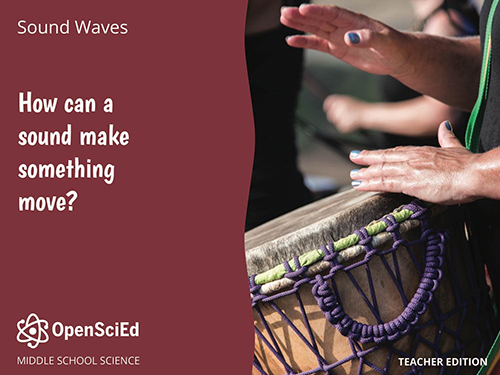
In this unit, students investigate how sounds can cause objects at a distance to move. Motivated by a video of windows shaking when a truck outside plays loud music, students investigate what happens when an object makes sound. Over the course of the unit, they build a model that describes what happens when sounds are created that can explain the shaking windows and other examples of sounds causing objects to move.
In this 8th grade unit, students use a particle model of air to build an understanding of how sounds move that explains the effect of sounds on other objects. They work on the practices of planning and conducting investigations, using mathematical and computational thinking, and evidence-based argumentation.
The consortium of curriculum developers includes BSCS, Boston College, the Dana Center at The University of Texas at Austin, Digital Promise Global, Northwestern University, and a broad network of leaders in science education. This developers consortium works in close collaboration with a state steering committee representing ten partner states from across the United States.
OpenSciEd is funded by the Carnegie Corporation of New York, Bill and Melinda Gates Foundation, Charles and Lynn Schusterman Family Foundation, and the William and Flora Hewlett Foundation.
The OpenSciEd initiative was launched to address a critical need in science education: the need for high quality science instructional materials that are standards-aligned and practical for broad implementation. BSCS Science Learning is currently leading the development of a one-year, high school physics course.
The program’s classroom materials and associated teacher professional learning materials are:
- designed to align with the NRC Framework for K-12 Science Education and the Next Generation Science Standards (NGSS),
- based on research on student learning and teacher practice,
- developed in collaboration with teachers and field-tested in hundreds of classrooms across the United States,
- open-source and locally adaptable, and
- continuously improved based on feedback from teachers and field testing.
The complete high school physics course will be freely available by early 2024.
Learn more below about the first physics unit, which is now available.
Energy Flow from Earth’s Systems

How can we design more reliable systems to meet our communities’ energy needs?
This high school unit is designed to introduce students to the concept of energy transfer in a relevant and grounded context: the Texas power crisis of February 2021. Students read articles and wonder about the complex social, environmental, and physical realities that led to such a crisis. They figure out how energy transfers between systems from a generator to our communities, and what makes an energy source reliable. This allows the class to model and explain what happened in Texas at multiple scales, from the electrons in the wires to the power companies making difficult decisions to maintain stability.
Students consider engineering tradeoffs, criteria, and constraints inherent in making decisions about our energy systems, and apply them in a culminating task: design a reliable energy solution that meets our communities’ needs, as articulated by interviews with friends and family members. The task is designed to give students the tools to speak up in their local and global community for a better energy future, one that aligns with their own values, and those of their families.
Learn more and download free unit here.
How can we design a stable trellis to support our climbing pea plants? How can we attract bees to our garden? How can we keep our plants warm in the cold winter months? These are important questions for farmers or gardeners trying to cultivate food. Students in 3rd-5th grade are now addressing these questions too.
Elementary educators are encouraged to facilitate students in engineering design to meet the expectations of the Next Generation Science Standards (NGSS). BSCS Science Learning, in collaboration with Life Lab, developed the Engineering in the Garden program to help 3rd-5th grade teachers and garden educators engage students in designing solutions to address real-world problems that arise in schoolyards and school gardens.
The program is designed to enhance educators’ understanding of the engineering design process and their confidence to facilitate engineering in the garden. Engineering in the Garden centers around the “Designing Trellises” unit, a model garden-based engineering unit in which students design trellises to support pea plants. Students consider how to design and build trellises that will stay stable and support peas as they climb. Students research peas’ needs, develop prototypes, design and build full-size trellises in the schoolyard, test those trellises in a range of likely environmental conditions, revise their designs, and plant and grow peas. The unit demonstrates how to use gardens as an authentic context for integrating science with engineering.
The program also offers resources to help educators design and facilitate their own garden-based engineering units, including an engineering process framework, guiding principles for garden-based engineering, planning tools, and videos of educators in action.
Life Lab offers the 2-day Engineering in the Garden workshop annually at their educational garden classroom in Santa Cruz, California. All the program resources are also freely available.
This work is supported by the Agriculture and Food Research Initiative’s Professional Development for Agricultural Literacy Program [(award no. 2020-67037-31047/project accession no. 1021998)] from the USDA National Institute of Food and Agriculture. Any opinions, findings, conclusions, or recommendations expressed in this publication are those of the author(s) and should not be construed to represent any official USDA or U.S. Government determination or policy.
What is the best time of year to host a lilac blossom festival? Does a plastic bag tax work to reduce litter in the environment? Students now have the opportunity to explore large data sets to answer questions like these and ultimately increase their confidence in analyzing data.
BSCS Science Learning has launched Invitations to Inquiry to help middle and high school students work with community and citizen science data from projects hosted on FieldScope—BSCS’s platform for collecting, displaying, and analyzing data. Invitations to Inquiry are activities in which students explore FieldScope’s mapping and graphing tools to dig into data in the context of meaningful questions.
Each lesson engages students in interpreting graphs and maps to learn about where the data are collected and what they mean. In one Inquiry, students use data from the Chesapeake Bay estuary to determine suitable sites for oyster reef restoration. In another, students investigate light pollution using a data set collected by individuals throughout the globe.
The Invitations are designed for 2-4 days of learning and support the science and engineering practices from the Next Generation Science Standards. They include teacher guides, slides, handouts, and other instructional resources and supports. Although the Invitations are designed for classroom learning with computer access, each activity offers an opportunity for students to collect data and contribute to a community science project.
Access BSCS’s Invitations to Inquiry for the classroom. Educators and parents supporting learning at-home can access student-directed versions of Invitations to Inquiry.
This work is funded by a grant from the Pisces Foundation .
Middle school educators across the US are expected to dive into next generation science. However, high quality NGSS-aligned materials and professional learning opportunities are scarce. That’s why BSCS’s 3-D middle school science program—A Medical Mystery—is valuable. It supports teachers in the effective instruction of an NGSS-aligned, EQuIP-reviewed body systems curriculum unit.
Students using this program are immersed in an online environment that challenges them to solve the medical mystery: “What’s Wrong with M’Kenna?” Over the course of several lessons, students investigate how and why M’Kenna is constantly sick, unable to keep her food down, and losing weight. They use scientific reasoning skills and argumentation to identify the digestive system as the problematic organ system—and then engage with a series of interactive experiences, simulations, and animations to observe and analyze the differences between M’Kenna’s digestive system and a healthy person’s digestive system.
Ultimately, students solve the mystery and explain all of M’Kenna’s symptoms based on how body systems interact. More importantly, they learn to use the inquiry-based practices of scientists and crosscutting concepts of systems and system models to construct their own understanding of complex phenomena.
This resource includes the complete middle school science curriculum unit and a teacher’s guide. The curriculum received a badge from the EQuIP review, indicating it is an example of high quality NGSS instruction.
Planning for online instruction? This document will help you quickly adapt A Medical Mystery for your new online classroom setting.
NGSS Design Badge
Awarded: Jan 4, 2022
Awarded To: A Medical Mystery
This resource was developed in partnership with OPB.
This material is based upon work supported by the National Science Foundation under Grant No. (DRL-1502571). Any opinions, findings, and conclusions or recommendations expressed in this material are those of the author(s) and do not necessarily reflect the views of the National Science Foundation.
Educators in central O’ahu want to immerse students in traditional and next generation science learning in a way that deepens their connection to the place of Hawaiʻi. With this goal in mind, the Leilehua-Mililani-Waialua Complex partnered with BSCS Science Learning to co-design and field-test a new curriculum unit for middle school students.
The resulting science unit, Restoring Ea, is place-based, three-dimensional, and phenomenon-focused. While specifically designed for seventh grade teachers and students in central O’ahu, Restoring Ea could be adapted and used by middle school teachers across the country who are looking to engage their students in meaningful, next generation science learning.
The Restoring Ea unit includes classroom materials and associated professional learning resources. It is now freely available.
About the Unit
Restoring Ea is a place-based middle school science unit exploring management strategies that could be used for the Loko ea fishpond to sustainably feed people and ensure the ecosystem is healthy and pono (balanced). This unit honors and leverages traditional and scientific ways of knowing to create experiences that connect students to ‘āina (land) through investigations of place. Focused on ecosystems and food sovereignty, students begin with an exploration of food shortages during emergencies and learn that Hawai’i imports most of its food, including fish. Students wonder how their kūpuna (ancestors) fed themselves prior to importing food. They learn that loko i’a (fishponds) used to feed many people, and one fishpond, Loko ea, is being restored to improve the ecosystem and feed people. Local teachers and students visit Loko ea to kilo (observe), hear mo’olelo (stories) about her past and present, and participate in stewardship activities. In the classroom, teachers help their students investigate the relationships between the desired fish and other key organisms that live at Loko ea. Students consider the ideal environmental conditions for the desired fish and how changes to the environmental conditions affect Loko ea and her organisms.
This unit leverages BSCS’s FieldScope interactive community & citizen science platform to allow students to investigate environmental data previously collected at Loko ea over time and also to collect additional data themselves.
The National Oceanic and Atmospheric Administration funded the co-design and field-testing of this unit.
This 6th grade unit on weather, climate, and water cycling is broken into four separate lesson sets. In the first two lesson sets, students explain small-scale storms. In the third and fourth lesson sets, students explain mesoscale weather systems and climate-level patterns of precipitation. Each of these two parts of the unit is grounded in a different anchoring phenomenon.
The unit starts out with anchoring students in the exploration of a series of videos of hailstorms from different locations across the country at different times of the year. The videos show that pieces of ice of different sizes (some very large) are falling out of the sky, sometimes accompanied by rain and wind gusts, all on days when the temperature of the air outside remained above freezing for the entire day. These cases spark questions and ideas for investigations, such as investigating how ice can be falling from the sky on a warm day, how clouds form, why some clouds produce storms with large amounts of precipitation and others don’t, and how all that water gets into the air in the first place.
The second half of the unit is anchored in the exploration of a weather report of a winter storm that affected large portions of the midwestern United States. The maps, transcripts, and video that students analyze show them that the storm was forecasted to produce large amounts of snow and ice accumulation in large portions of the northeastern part of the country within the next day. This case sparks questions and ideas for investigations around trying to figure out what could be causing such a large-scale storm and why it would end up affecting a different part of the country a day later.
Weather, Climate and Water Cycling is aligned to the Next Generation Science Standards and is freely available for download. This unit is part of the OpenSciEd middle school science program. BSCS Science Learning lead a consortium of organizations and science education experts in the development of this three-year program for grades 6-8.
This 7th grade unit on matter cycling and photosynthesis begins with students reflecting on what they ate for breakfast. Questions about where their food comes from lead them to consider which breakfast items might be from plants. Then students explore (and taste) a common breakfast food, maple syrup, and see that according to the label, it is 100% from a tree.
Students apply what they learned in the previous unit to argue that they know what happens to sugar in syrup or other foods when they consume it. Students explore what else is in food and discover that foods from plants not only have sugars but proteins and fats as well. This discovery leads them to wonder how plants are getting these food molecules, why a plant needs food, and where a plant’s food comes from in the first place. Students figure out that they can trace all food back to plants, including processed and synthetic food. They explain that the pieces of their food are constantly recycled between living and nonliving parts of a system.
Matter Cycling & Photosynthesis is aligned to the Next Generation Science Standards and is freely available for download. This unit is part of the OpenSciEd middle school science program. BSCS Science Learning lead a consortium of organizations and science education experts in the development of this three-year program for grades 6-8.
This 8th grade unit launches with a slow motion video of a speaker vibrating. After developing a model of sound in the previous unit, students now have the chance to explore the cause of a speaker’s vibration as opposed to the effect.
Students dissect speakers to explore what’s inside, and they build homemade cup speakers. They identify that speakers of all kinds have some of the same parts—a magnet, a coil of wire, and a membrane. Students investigate each of these parts to figure out how they work together in the speaker system. Along the way, students manipulate the parts to see how this technology could be modified to apply to systems in very different contexts, like MagLev trains, junkyard magnets, and electric motors.
Forces at a Distance is aligned to the Next Generation Science Standards and is freely available for download. This unit is part of the OpenSciEd middle school science program. BSCS Science Learning lead a consortium of organizations and science education experts in the development of this three-year program for grades 6-8.